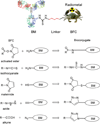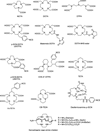Metallic radionuclides in the development of diagnostic and therapeutic radiopharmaceuticals
- PMID: 21541393
- PMCID: PMC3716284
- DOI: 10.1039/c1dt10379b
Metallic radionuclides in the development of diagnostic and therapeutic radiopharmaceuticals
Abstract
Metallic radionuclides are the mainstay of both diagnostic and therapeutic radiopharmaceuticals. Therapeutic nuclear medicine is less advanced but has tremendous potential if the radionuclide is accurately targeted. Great interest exists in the field of inorganic chemistry for developing target specific radiopharmaceuticals based on radiometals for non-invasive disease detection and cancer radiotherapy. This perspective will focus on the nuclear properties of a few important radiometals and their recent applications to developing radiopharmaceuticals for imaging and therapy. Other topics for discussion will include imaging techniques, radiotherapy, analytical techniques, and radiation safety. The ultimate goal of this perspective is to introduce inorganic chemists to the field of nuclear medicine and radiopharmaceutical development, where many applications of fundamental inorganic chemistry can be found.
Figures















References
-
- Bucerius J, Ahmadzadehfar H, Biersack H. 99mTc-Sestamibi Clinical applications. 1st edn. Germany: Springer; 2011. (ISBN: 978-3-642-04232-4)
- Sheikine Y, Berman D, Di Carli MF. Clin. Cardiol. 2010;33:E39–E45. - PMC - PubMed
- Fleming RM, Harrington GM, Baqir R, Jay S, Sridevi C, Avery K, Jim G. Metho. DeBakey Cardio. J. 2009;5(3):42–48. - PubMed
-
- Gupta VK. J. Med. Phys. 1995;20:31.
-
- Hoskin P, Coyle C. Radiotherapy in Practice: Brachytherapy. NY: Oxford University Press; 2005.
-
- Welch MJ, Redvanly CS. Handbook of radiopharmaceuticals: radiochemistry and applications. New York: Wiley; 2003.
Publication types
MeSH terms
Substances
Grants and funding
LinkOut - more resources
Full Text Sources
Other Literature Sources

